FIG Commission 7 Cadastre and Land Management Annual Meeting
2011
26-30 September 2011, Innsbruck, Austria
|
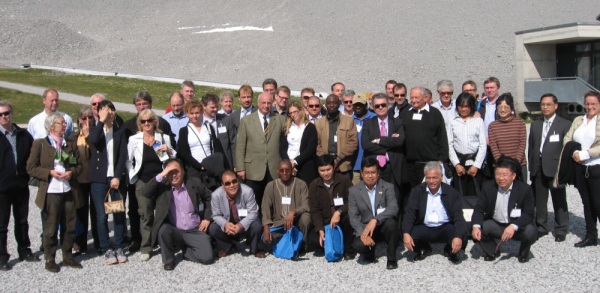
Group of participants to FIG Com7 Annual Meeting
|
FIG Commission 7 held his annual meeting from Sept. 26th to 30th 2011 in
the wonderful city of Innsbruck, Austria. This very successful event
culminated with the high level International Symposium Cadastre 2.0. This
meeting welcomed delegates from 30 countries among them FIG Vice President
Professor Chryssy Potsiou, former Chairs of Commission 7 Andrzej
Hopfer, Ian Williamson, Paul MunroFaure and András
Osskó. Without any doubt, issues related to land administration and
cadastral perspectives are still of very high interest, namely in regard of
citizens’ involvement, crowd sourcing and social medias. And to completion
of cadastre and land registration in the developing world, this concerns
about 75% of the 6 billion or so spatial units in use by humans on the
planet.
In brief:
- The future of cadastre is high on the agenda of the FIG Commission
7. Jürg Kaufmann and Ian Williamson shared their thoughts with the
Commission.
- Many discussions about one hand the need for a AAA Cadastre
(Accurate, Authoritative, Assured) for the some advanced countries and
on the other hand, the immediate need for low cost solutions to meet the
challenge of population in developing countries. There are different
opinions and solutions.
- Developments of 3D cadastre have been discussed. This will be one of
the important attention points in the work of the Commission, as well as
management of government lands, pro poor land tools (with UN-HABITAT),
spatial enabled societies, climate change, the cadastral template and
the ISO Land Administration Domain Model.
- There was a contribution on the European Measurement Code for the
floor and area of buildings and in general attention to condominium
rights with cases from Italy.
- The technology will take over the work of surveyors in land
registration more and more. This work can be done by many people based
on a very short education. We will not see cadastral surveyors in the
field so much in the future.
- Surveyors role and contribution to land administration is under
change from field surveys to information and quality management of
spatial data and being supportive and leading in developments of
national spatial data infrastructures with a broad application range.
This can only be done in close co-operation with professionals from
other disciplines. Reliability of data is the key contribution of our
profession.
- It will be possible that people develop their own cadastre based on
infrastructures as Google and Facebook.
- Developments of cadastral systems in Asia; e.g. Malaysia and Korea
are very impressive; also in support of huge land reforms.
- Our colleagues from Africa need support for their actions in
relation to their governments. FIG will not take a position in political
discussions, but will provide alternative approaches, checklists in
implementation alternatives – e.g. in relation to land grabbing as it
can be observed in many countries; in co-operation with FAO.
- Disaster management and importance of cadastre was discussed. An
example from Hungary illustrated the need of combining data from
different sources in case of disaster.
- Impact of earth quakes and tsunamis for cadastre was discussed with
cases from Japan and New Zealand. Rapid relief based on cadastral
information.
- A very interesting visit to the BEV Cadastral Office of Kufstein.
Austria was one of the very first countries with a digital cadastre and
land registration.
- A very impressive guiding tour of the Construction of the Lower Inn
Valley Railway Tunnel Site.
Some quotes:
- Politicians don’t want to hear about cadastre. They want to solve
problems – Ian Williamson
- We are the generation that has made the shift from paper documents
to digital cadastre – Christiaan Lemmen
- Crowd-sourcing within the emerging spatially enabled society is
opening up opportunities to fundamentally rethink how professionals and
citizens collaborate in land administration. Let’s try it! Let’s pilot
it! – Robin McLaren
- Mobile phone is the laptop of developing countries – Brent Jones
- Listen to what people are trying to do – Matthew Delano
- Only surveyors care about accuracy – Gavin Adlington
- Future cadastre will be 3D, monitoring dynamics based on history
data, multifunctional and multi jurisdictional, integration in social
networks and it will become an essential element of the knowledge
society – Giorgio Pauletto
-
Crowd-sourcing has been used successfully in some contexts to improve
geographical data. It is now an option that cadastral organization will
have to consider in order to support and advance the normal process. -
Chryssy Potsiou
- There is a world outside the surveyors’ community building up a
parallel system. We need to find how to co-operate with these groups –
Gerda Schennach
There is an urgent need for knowledge and information on the latest
developments in cadastre and land registry in many countries; the work of
the commission (reports, cadastral template, proceedings) are used for this
purpose. This could be even better communicated. And the link with Géomètres
sans Frontières to be strengthened; a challenge for the young generation of
surveyors.
Commission 7 wants to thank the Austrian Society for Surveying and
Geoinformation and more specifically Mrs Gerda Schennach, Vice-Chair
of Commission 7, for organizing such a perfect meeting.
For more details, see the FIG Commission 7 website:
http://www.fig.net/commission7/index.htm
Daniel Roberge, Chair
FIG Commission 7
 |
The Proceedings of the International FIG
Symposium "Cadastre 2.0" are obtainable.
Price € 25,-- incl. tax and postage. Please order it
here
Further information on the symposium:
|
|
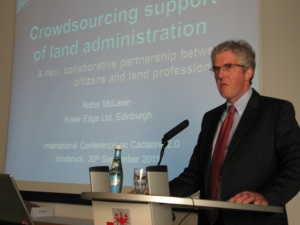
Robin McLaren speaking at the International Symposium Cadastre 2.0 |
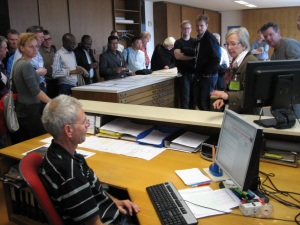
Visit to the BEV Cadastral Office of Kufstein
|
|
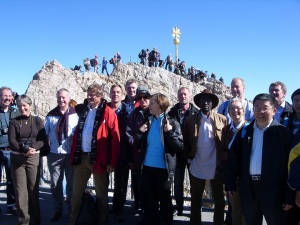
A group of participants visiting the German-Austrian state boundary
at Zugspitze |
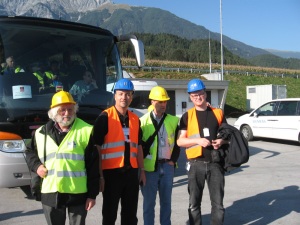
Visit to the Construction Lower Inn Valley Railway Site
|
14 October 2011
|

